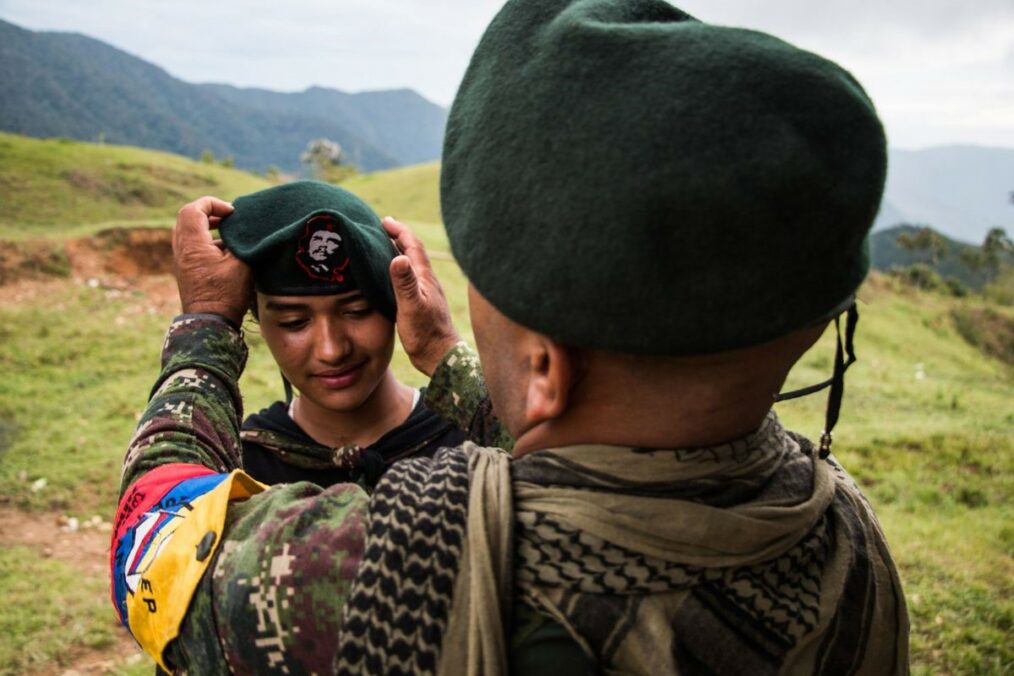
The Revolutionary Armed Forces of Columbia (Fuerzas Armadas Revolucionarias de Colombia) – Does joining terrorist groups challenge gender roles within society?
Photographer: Nicolas Bedoya
Source: Bloomberg
The Revolutionary Armed Forces of Columbia (Spanish: Fuerzas Armadas Revolucionarias de Colombia) is a violent extremist group founded in 1964. The FARC is a Marxist-Leninist group that aims to redistribute wealth within the country and reform the government of Colombia. Their main tactics have been involvement in criminal organizations and challenging the Colombian government by way of terrorist attacks, including things like car bombs injuring civilians and attacks on government military forces like police and soldiers.
The FARC is considered a terrorist group by the Colombian government and other nations around the world. This organization has a significant number of female members and some completely female factions. At one point in time the group’s female members comprised 40% of the group’s members.
After 52 years of violent conflict against the Columbian government, this violent communist group agreed to peace. In 2017, the group rebranded itself to become the Common Alternative Revolutionary Force. At this time it became an official political party and disarmed itself. Although the group officially agreed to demobilization, dissident rebels with ties to the FARC still incite conflict and have continued to carry out attacks in recent years.
Women who joined the FARC express that their motivation came from their grievances that were not being addressed in normal Colombian society. Things like lack of opportunity for women, lack of education, poverty, and social inequality were all factors in the recruitment of women into this group. Joining the violent group allowed women to have leadership roles and gave a sense of purpose to a life within which they felt stuck. Membership in the group offered women “relative autonomy and a control over their lives” that was not accorded to them in the often patriarchal and rural societies of Colombia. Women state they joined in order to have leadership opportunities and escape traditional norms.
Rather than depicting female extremists as victims of radicalization who were lured or brainwashed into violent roles, this demonstrates that women turned to extremism to attempt to subvert their victimhood, which was derived from a patriarchal context, and not the violent group they chose to join. As such, one should not essentialize men and women to assume that they have inherently different reasons for choosing to join extremist groups. Instead, more emphasis should be placed on the opportunities and conditions within particular society that would lead women, and men, to this path of radicalization.
Women who are in leadership roles within the FARC can move from background or supporting positions to frontline jobs, allowing women to experience some emancipation from strict gender roles in their own societies. Being part of this extremist group has provided a place from which women can make political statements about their qualms with patriarchal and society void of opportunity by using violence. But should women really have to turn to violence in order for their voices to be heard? Further, do the leadership roles they enjoy within the FARC transfer into their civilian lives and everyday societies in Columbia?
Female extremists participating in the violence of terrorist groups is thought to incite the participation of others and garner popular support. In some societies with a traditional sense of gender roles, women are expected to stay in the home. As such, if women are vying for a particular cause and resorting to violent groups then it may be viewed as more dire a situation because they have had to ‘leave the home’. Women are undoubtedly an asset to violent groups. But are their contributions inherently valued or are women merely serving as additional bodies and fodder for violent attacks? Thus, are women really being liberated from their traditional role if they are “expendable assets to serve terrorists group nefarious agendas”?
The Colombian government attempted to provide demobilization programs to fighters in order to re-integrate them back into society. With the resurgence of violence, even after peace agreements, the program does not seem to be working. Although these women mostly cite their experiences in the FARC as positive ones, their autonomy and agency in their militarized roles made it harder for them to integrate back into life after their role in the conflict was over.
Disappointingly, some programs that attempt to reintegrate women back into society by way of employment opportunities fall right back into gender roles by offering women jobs in industries like hairdressing or being seamstresses. Overall, programs and policies that provide assistance to ex-extremists must pay more attention to why these women chose to join in the first place in order to dissuade the potential of recurring violence in the future.
Amy Hetherington
Amy is working on her MA thesis in Peace and Conflict in the School of Politics and International Relations at University College Dublin. Her course work focuses on religious extremism and political violence in the Middle East and North Africa. Amy’s thesis work examines the correlates for support/sympathy for Islamic terrorism in Muslim majority countries. Amy completed her undergraduate degree at Queen’s University, Canada in Religious Studies and World Languages with an International certificate. At Rise to Peace, Amy is a counter-terrorism research intern within the department for Women Extremism.
